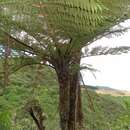tr
kırıntılardaki isimler


Alsophila cunninghamii, synonym Cyathea cunninghamii,[1] also known as the gully tree fern and slender tree fern, is a species of tree fern indigenous to New Zealand[2] including North Island (type locality), South Island and Chatham Islands; also to Victoria, possibly New South Wales, southeastern Queensland and Tasmania in Australia.[3]: 36 It grows in damp forest, often emerging from stream gullies and riverbanks. Brownsey[2]: 103 noted that it has a lower tolerance for drought than other related species. The erect trunk may be 20 m tall and is usually 6–15 cm in diameter, occasionally as much as 20 cm. Fronds are tri- to tetrapinnate and 3 m or more in length. The rachis and stipe are slender, black brown, warty and covered with brown scales. Sori occur along each side of the pinnule midvein and are covered by hood-like indusia. A. cunninghamii is an uncommon and slow-growing tree fern.
Plants from New Caledonia known as Alsophila stelligera may represent the same species.[4]: 118
In the wild, A. cunninghamii hybridises with Alsophila australis to form the fertile hybrid Alsophila × marcescens.[2][3]: 38 [4]
To do well in cultivation, A. cunninghamii requires moisture. Rich humus is a good growing medium. Plants should be protected from the wind.
The specific epithet cunninghamii commemorates Allan Cunningham (1791-1839), a botanist who traveled widely in Australia and New Zealand.
Alsophila cunninghamii, synonym Cyathea cunninghamii, also known as the gully tree fern and slender tree fern, is a species of tree fern indigenous to New Zealand including North Island (type locality), South Island and Chatham Islands; also to Victoria, possibly New South Wales, southeastern Queensland and Tasmania in Australia.: 36 It grows in damp forest, often emerging from stream gullies and riverbanks. Brownsey: 103 noted that it has a lower tolerance for drought than other related species. The erect trunk may be 20 m tall and is usually 6–15 cm in diameter, occasionally as much as 20 cm. Fronds are tri- to tetrapinnate and 3 m or more in length. The rachis and stipe are slender, black brown, warty and covered with brown scales. Sori occur along each side of the pinnule midvein and are covered by hood-like indusia. A. cunninghamii is an uncommon and slow-growing tree fern.
Plants from New Caledonia known as Alsophila stelligera may represent the same species.: 118
In the wild, A. cunninghamii hybridises with Alsophila australis to form the fertile hybrid Alsophila × marcescens.: 38
To do well in cultivation, A. cunninghamii requires moisture. Rich humus is a good growing medium. Plants should be protected from the wind.
The specific epithet cunninghamii commemorates Allan Cunningham (1791-1839), a botanist who traveled widely in Australia and New Zealand.
Alsophila cunninghamii, sinónimo Cyathea cunninghamii,[1] es un helecho arbóreo esbelto autóctono de Nueva Zelanda[2] incluidas la Isla Norte (localidad tipo), las islas Sur y Chatham; y Australia en Victoria, posiblemente Nueva Gales del Sur, el sureste de Queensland y Tasmania.[3]:36 Crece en bosques húmedos, a menudo emergiendo de quebradas y riberas. Brownsey[2]:103señaló que tiene una menor tolerancia a la sequía que otras especies relacionadas. El tronco erecto puede tener 20 m de altura y generalmente tiene 6–15 cm de diámetro, ocasionalmente hasta 20 cm. Las frondas son tri a tetrapinnadas y tienen 3 m o más de longitud. El raquis y el estípite son delgados, de color marrón negro, verrugosos y cubiertos de escamas marrones. Los soros se presentan a lo largo de cada lado de la nervadura central de la cápsula y están cubiertos por un indusio con forma de capucha. A. cunninghamii es un helecho arbóreo poco común y de crecimiento lento.
Las plantas de Nueva Caledonia Alsophila stelligera puede que sean la misma especie.[4]:118
En su ambiente natural, A. cunninghamii se hibridiza con Alsophila australis para dar el híbrido fértil Alsophila × marcescens.[2][3]:38[4]
Alsophila cunninghamii, sinónimo Cyathea cunninghamii, es un helecho arbóreo esbelto autóctono de Nueva Zelanda incluidas la Isla Norte (localidad tipo), las islas Sur y Chatham; y Australia en Victoria, posiblemente Nueva Gales del Sur, el sureste de Queensland y Tasmania.:36 Crece en bosques húmedos, a menudo emergiendo de quebradas y riberas. Brownsey:103señaló que tiene una menor tolerancia a la sequía que otras especies relacionadas. El tronco erecto puede tener 20 m de altura y generalmente tiene 6–15 cm de diámetro, ocasionalmente hasta 20 cm. Las frondas son tri a tetrapinnadas y tienen 3 m o más de longitud. El raquis y el estípite son delgados, de color marrón negro, verrugosos y cubiertos de escamas marrones. Los soros se presentan a lo largo de cada lado de la nervadura central de la cápsula y están cubiertos por un indusio con forma de capucha. A. cunninghamii es un helecho arbóreo poco común y de crecimiento lento.
Las plantas de Nueva Caledonia Alsophila stelligera puede que sean la misma especie.:118
En su ambiente natural, A. cunninghamii se hibridiza con Alsophila australis para dar el híbrido fértil Alsophila × marcescens.:38
Cyathea cunninghamii là một loài dương xỉ trong họ Cyatheaceae. Loài này được Hook. f. mô tả khoa học đầu tiên năm 1854.[1] Danh pháp khoa học của loài này chưa được làm sáng tỏ.
Cyathea cunninghamii là một loài dương xỉ trong họ Cyatheaceae. Loài này được Hook. f. mô tả khoa học đầu tiên năm 1854. Danh pháp khoa học của loài này chưa được làm sáng tỏ.